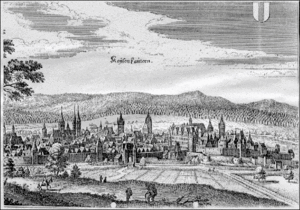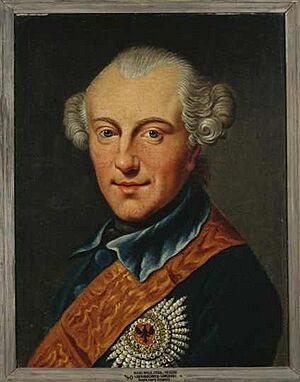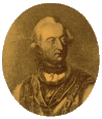Battle of Kaiserslautern facts for kids
The Battle of Kaiserslautern (November 28–30, 1793) was an important fight during the French Revolution. It happened near the city of Kaiserslautern in what is now Germany. In this battle, an army of soldiers from Prussia and Saxony, led by Duke of Brunswick, faced off against a French army led by Lazare Hoche. The battle lasted three days, and the Prussian and Saxon forces won, stopping the French attacks.
Quick facts for kids Battle of Kaiserslautern |
|||||||
|---|---|---|---|---|---|---|---|
| Part of the French Revolution | |||||||
 Kaiserslautern, engraving after Merian |
|||||||
|
|||||||
| Belligerents | |||||||
| Commanders and leaders | |||||||
| Strength | |||||||
| 26,000 | 36,000 | ||||||
| Casualties and losses | |||||||
| 806–1,300 | 2,000–3,100 2 guns, 1 color |
||||||
Contents
Before the Battle
In July 1793, the Duke of Brunswick's army successfully captured the city of Mainz from the French. After this, the French armies, the Army of the Rhine and the Army of the Moselle, had to retreat. The French government was worried and changed their army commanders several times.
Eventually, Lazare Hoche was chosen to lead the Army of the Moselle. His main goal was to help the French city of Landau, which was surrounded by enemy forces. Hoche's army had about 36,000 soldiers. In November 1793, Hoche began to move his army forward, pushing back the Duke of Brunswick's forces towards Kaiserslautern.
The Duke of Brunswick decided to make a stand and fight at Kaiserslautern. Hoche, thinking he had the enemy on the run, tried to find Brunswick's army. After some confusion, the French army marched towards Kaiserslautern in three separate groups.
Armies and Leaders
The Duke of Brunswick's army had about 26,000 soldiers from Prussia, Saxony, and their allies. These forces were organized into divisions, each led by experienced generals like Ludwig Karl von Kalckstein, Nikolaus Heinrich von Schönfeld, and Friedrich Adolf, Count von Kalckreuth. They had many infantry (foot soldiers), cavalry (horse soldiers), and artillery (cannons).
The French Army of the Moselle, led by Lazare Hoche, was larger with about 36,000 soldiers. This included nearly 30,000 infantry and over 5,000 cavalry, along with 52 cannons. The French army was divided into an advance guard and several divisions, led by generals like Paul-Alexis Dubois, Jean-Jacques Ambert, Louis Pierre Huet, Alexandre Camille Taponier, and Rémy Vincent. Many of the French soldiers were volunteers from the National Guard, who were enthusiastic but not always as well-trained as the professional Prussian soldiers.
Day One: The Fight Begins
On November 28, the French army attacked the Prussian positions. The Duke of Brunswick had set up his army with its right side protected by the city of Kaiserslautern and the nearby Lauter River.
The French attacked in three columns. General Taponier's column on the right was the first to meet the Prussians. They had some success, pushing onto the Hoheneck heights. General Ambert's column on the left tried to cross the Lauter River. The Duke of Brunswick sent General Kalckreuth north to stop Ambert.
Hoche's main column in the center faced difficult roads and couldn't join the fight on the first day. Ambert's men managed to cross the river and attacked several times, but they were outnumbered and had to retreat. Despite these difficulties, Hoche decided to focus his main attack on the left side the next day.
Day Two: French Attacks Continue
On November 29, the French army crossed the river in greater numbers. Dubois's advance guard and Olivier's brigade attacked the Prussian defenses, but it was a tough fight. Hoche set up large cannon batteries to fire at the Prussians.
General Ambert's division tried to go around the Prussian position at Otterberg, while Huet's division attacked the enemy head-on. The Prussians fell back under the heavy cannon fire, allowing the French to cross the Otterbach stream.
Hoche then launched a large attack of 10,000 soldiers against the Prussian left side. However, Saxon cavalry charged Huet's division, causing the French infantry to pull back. French cavalry tried to help, but the Saxons held their ground. Attacks on other parts of the Prussian line also failed. By the end of the day, the fighting died down.
Day Three: The Final Push
Hoche continued his attacks on November 30. At dawn, his cannons began firing again. On the left, French soldiers tried to capture the Buchberg hill but were pushed back after a fierce fight with the Saxons. The arrival of more Prussian troops from the north forced the French to retreat quickly from this area.
Other French attacks on different hills also failed. The fighting was intense, with both sides' cavalry charging and counter-charging. On the French right, Taponier made two more attempts to take the Galgenberg hill, but the Duke of Saxe-Weimar's troops successfully defended it.
After making sure his own army's sides were secure, the Duke of Brunswick launched a counterattack. Seeing that his left side was being outflanked (attacked from the side) by the Saxons, Hoche ordered a full retreat. His tired troops pulled back across the river and headed towards Zweibrücken, Hornbach, and Pirmasens. The Duke of Brunswick did not chase them, following his king's orders to be cautious.
What Happened Next?
The Battle of Kaiserslautern was a clear victory for the Prussian and Saxon forces. The French army suffered more losses, with estimates ranging from 2,000 to over 3,000 soldiers killed, wounded, or captured, along with two cannons and a flag. The Prussian and Saxon forces lost around 800 to 1,300 soldiers.
Despite the defeat, the French soldiers' spirits remained high. Hoche quickly began to fortify his positions and made it seem like he was going to attack Brunswick again. However, this was a trick. Hoche's real plan was to move a large part of his army to attack the western side of another enemy army, led by General Wurmser, in a different area.
This change in strategy led to another important battle in December 1793, the Battle of Froeschwiller, where Hoche achieved a victory.
Images for kids










